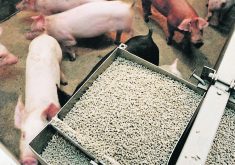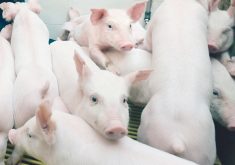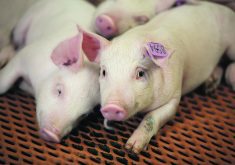At the Emerson-Pembina border, two loads of weanling pigs were moving through the inspection process — more quickly than the passenger vehicles going through.
They were likely heading to the Midwest, where millions of Manitoba pigs go every year.
The border guard asked a reporter if he was carrying any food products. Only a few muffins, was the reply. The reporter was allowed to carry on toward Des Moines, Iowa, where much of North America’s hog industry was gathering for the World Pork Expo.
Along the interstates of North Dakota, Minnesota and Iowa, hundreds of Manitoba-plated trucks rumbled, carrying manufactured goods down to or back from the United States. Much farm machinery was moving both ways. It’s an international agricultural superhighway.
Read Also

Huge Black Sea flax crop to provide stiff competition
Russia and Kazakhstan harvested huge flax crops and will be providing stiff competition in China and the EU.
At the World Pork Expo, it was easy to find Canadian companies. Quebec companies, Manitoba companies and Ontario companies all took up floor space, where thousands of producers and pork industry people from around the world milled, chatted and made deals.
The Canada-U.S. border didn’t seem to exist. Nor were other international borders stopping people in the global hog and pork business from coming and doing business. Danish and Chinese companies were proudly residing inside trade show allotments, as were providers from many other nations.
The Western Producer reporter chatted with producers from Ukraine, Peru, Vietnam and Japan. For those seeking ideas, knowledge, contacts and business, international borders meant little.
But the borders and border issues were everywhere, all around, inescapable.
The most popular person at this year’s World Pork Expo was Ozcar, a beagle employed by the U.S. Customs and Border Protection Agency to sniff out smuggled, snuck-in and innocently transported food products at Chicago’s O’Hare airport.
Ozcar and dozens of fellow canines are used at airports to catch potentially dangerous foreign foods brought in by passengers.
He was cute, but his job is a deadly serious part of how we can use borders to help cut the risk of foreign animal diseases, just as the border checks at Pembina were being used to ensure Canadian-born agricultural diseases weren’t being imported by the pigs or the reporter.
Political border issues hung over the expo. That line between the U.S. and Canada is giving producers the willies because of voluntary country-of-origin labelling rules that could snarl the flow of pork in North America’s highly integrated industry.
The border between California and the rest of the world might become the Great Wall Against Pork if the Proposition 12 regulations reveal North America does not produce enough Prop 12 compliant meat for the state’s bigger-than-Canada population.
What happens if African swine fever appears in Puerto Rico? Does that mean the U.S. would be considered infected? That border determination might mean a lot.
When ASF appears on our mainland, border lines will immediately matter, as countries slap up border controls against pork based on national origin, not nearness to infection.
North American producers want the border with China to not exist when it comes to exports. But with anti-China rhetoric heating up, nobody’s expecting U.S.-China trade to get any less fraught with tension.
Sometimes, borders haven’t seemed to matter with agricultural employment. Millions of Latin American workers have filled the fields and packing plants of California and the U.S. Midwest for decades, and farmers would like to keep it that way.
As in Canada, native-born workers show little interest in hard, rural, poor-paying and seasonal work in American agriculture.
But in recent years, the hostility of many Americans to immigration has pushed U.S. authorities into new laws and regulations, and into enforcing existing regulations, so that both the flow and availability of these workers have become much restricted.
Farmers and the pork industry would like the borders to be thin and loose, but for labour they’re getting thicker and harder.
Borders matter. They can work well. When they’re used like they are at Emerson-Pembina to limit the spread of disease, dangerous people and illegal goods, they can help trade flourish.
But when they’re used to chop up trade and business, they can become a human-made nightmare.
We’re seeing both border realities today and they aren’t going away any time soon.


















